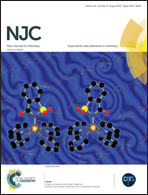Robustness of a thioamide {⋯H–N–C![[double bond, length as m-dash]](https://www.rsc.org/images/entities/char_e001.gif) S}2 synthon: synthesis and the effect of substituents on the formation of layered to cage-like supramolecular networks in coumarin–thiosemicarbazone hybrids†
S}2 synthon: synthesis and the effect of substituents on the formation of layered to cage-like supramolecular networks in coumarin–thiosemicarbazone hybrids†
Abstract
The applications of thioureas in crystal engineering have increased dramatically over the past few years. However, their analogs namely N-imino thioureas/thiosemicarbazones are largely ignored, despite the fact that these can be more interesting with respect to crystal engineering applications due to the presence of an additional N-imino moiety. Aiming to highlight their importance in crystal engineering/supramolecular chemistry, three structurally related coumarin–thiosemicarbazone hybrids (3a–3c) have been designed, synthesized and crystallographically characterized. All of the compounds showed a general preference for the adoption of the cis, trans conformation around the central thiourea moiety; a conformation which is ideal for the formation of a dimeric hydrogen-bonded R22(8){⋯H–N–C![[double bond, length as m-dash]](https://www.rsc.org/images/entities/char_e001.gif) S}2 synthon as the building block. Therefore, this dimeric synthon is observed in all of the compounds, regardless of the formation of layered to cage-like three dimensional supramolecular networks depending on different substituents. The prevalence of the cis, trans conformation and the robustness of the thioamide dimer synthon in thiosemicarbazones indicate its potential use as a design element in crystal engineering.
S}2 synthon as the building block. Therefore, this dimeric synthon is observed in all of the compounds, regardless of the formation of layered to cage-like three dimensional supramolecular networks depending on different substituents. The prevalence of the cis, trans conformation and the robustness of the thioamide dimer synthon in thiosemicarbazones indicate its potential use as a design element in crystal engineering.
![Graphical abstract: Robustness of a thioamide {⋯H–N–C [[double bond, length as m-dash]] S}2 synthon: synthesis and the effect of substituents on the formation of layered to cage-like supramolecular networks in coumarin–thiosemicarbazone hybrids](/en/Image/Get?imageInfo.ImageType=GA&imageInfo.ImageIdentifier.ManuscriptID=C5NJ00734H&imageInfo.ImageIdentifier.Year=2015)

 Please wait while we load your content...
Please wait while we load your content...
![[double bond, length as m-dash]](https://www.rsc.org/images/entities/h2_char_e001.gif) S}2 synthon: synthesis and the effect of substituents on the formation of layered to cage-like supramolecular networks in coumarin–thiosemicarbazone hybrids
S}2 synthon: synthesis and the effect of substituents on the formation of layered to cage-like supramolecular networks in coumarin–thiosemicarbazone hybrids